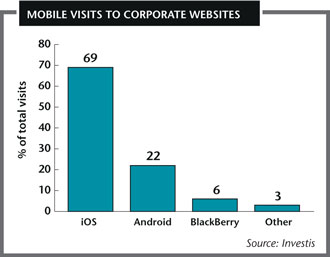Tim Human reports on the importance of keeping up with the traveling community
We all keep hearing about the importance of having a mobile strategy; it’s a bit like what we heard about China in the early 1990s. Still, that doesn’t mean it’s bad advice.
Mobile device use continues to surge: the number of mobile subscribers around the world hit 3.2 bn in 2012, according to management consultant AT Kearney, while Morgan Stanley predicts mobile internet users will surpass desktop internet users this year.
The use of mobile devices by investors is also on the rise. The amount of mobile traffic to corporate websites has doubled every year since 2010, says Marcus Fergusson, head of social media at digital communications firm Investis.
What’s more, IROs report tablets are now commonplace in meetings and at conferences. This all suggests mobile use is a topic worth thinking about. But there are lots of initial decisions to make.
Do you need an app, or will a mobile website do? Which operating systems should you focus on: Apple’s iOS or Android? Or both?
There are three main options when incorporating mobile into your digital communications: mobile sites, responsive design and apps, according to Q4 Web Systems, the Toronto-based provider of IR websites and online solutions.
In a new white paper entitled, ‘Mobile technologies for investor relations’, Q4 argues that mobile sites are a good first step, while responsive design, which adapts to the screen size being used, has the major advantage of allowing companies to create one website that responds well to all devices.
For Q4, however, the app is the best option of the three. Despite being the most expensive to develop, apps make the most of multimedia and interactive capabilities of mobile devices, as well as offering features such as notifications and calendar integration.
‘For IR departments with a loyal following looking to create an app or trying to strengthen their connection with investors, apps can provide the most immersive experience and will be highly valued by users,’ the firm argues in its white paper.
The main drawback of apps, notes Q4, is that they are specific to a device – so if you want to be on iPhones and Android phones, you’ll need to develop two apps. And a third if you want one on an iPad. This is where another piece of research comes in handy.
Despite the growing dominance of the Android system, there are proportionally few visits to corporate websites made from Android devices, notes a forthcoming guide from Investis called Why Mobile Matters.
The firm, which tracks traffic at 60 corporate websites across Europe, states that iOS use (combined iPhone and iPad traffic) continues to grow and now accounts for 69 percent of all visits.
Android, on the other hand, accounts for just 22 percent of visits. Notably, more than half of the iOS visits are from iPads, again highlighting the popularity of tablets in the business community.
‘The dominance of iOS is principally due to the iPad’s popularity among the IR and corporate audiences,’ explains Fergusson. ‘The iPad was the first to market and was rapidly adopted by the business world, to the exclusion of the devices that have followed.’
Browsing on Android devices has ‘long been a painful experience,’ Fergusson adds. ‘The number of Android devices out there may be high but time-pressed corporate users appear disinclined to browse on them. We expect this to change, however, with the release of newer Androids such as the Galaxy S4.’










